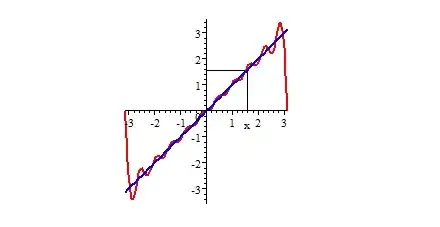Give the fourier series representation of $f(x) = x$ on $[-\pi, \pi]$.
Use the result to give the exact sum of...
$$\sum_{n=1}^\infty \frac{(-1)^{n+1}}{2n-1}$$
$$\text{ where } x \in [-\pi,\pi]$$
Give the fourier series representation of $f(x) = x$ on $[-\pi, \pi]$.
Use the result to give the exact sum of...
$$\sum_{n=1}^\infty \frac{(-1)^{n+1}}{2n-1}$$
$$\text{ where } x \in [-\pi,\pi]$$
I have the fourier series representation of: f(x) = 2[sin(x) - sin(2x) /2 + sin(3x) /3 ...] I'm having a hard time of giving the exact sum
EDIT. Since your computation agrees with $(2)$, you can skip the first part of this answer.

You can find another example on how to compute the sum of a series by means of an expansion of a function into a Fourier series in this answer.
Since $\;f\;$ is odd we shall only need the sine coefficients:
$$b_n=\frac1\pi\int\limits_{-\pi}^\pi t\sin nt\;dt$$
By parts:
$$u=t\;\;,\;\;u'=1\\v'=\sin nt\;,\;\;v=-\frac1n\cos nt$$
so
$$b_n=\left.\frac1\pi\left(-\frac tn\cos nt\right|_{-\pi}^\pi+\frac1n\int\limits_{-\pi}^\pi \cos nt\;dt\right)=$$
$$=\frac1\pi\left(-\frac\pi n\cos n\pi-\frac\pi n\cos n\pi\right)+\left.\frac1{\pi n^2}\sin nt\right|_{-\pi}^\pi=-\frac2n\cos n\pi=(-1)^{n+1}\frac{2}n$$
and from here
$$f(x)=\sum_{n=1}^\infty(-1)^{n+1}\frac 2n\sin nx$$
Take now $\;x=\frac\pi2\;$:
$$\frac\pi2=\sum_{n=1}^\infty(-1)^{n+1}\frac2n\sin\frac{n\pi}2=\sum_{n=1}^\infty(-1)^{n+1}\frac2{2n-1}$$
since
$$(-1)^{n+1}\frac2n\sin\frac{n\pi}2=\begin{cases}(-1)^{n+1}\frac2n&,\;\;n=1\pmod 4\\{}\\(-1)^n\frac2n&,\;\;n=3\pmod 4\\{}\\0&,\;\;n=0,2\pmod 4\end{cases}$$
$\newcommand{\+}{^{\dagger}} \newcommand{\angles}[1]{\left\langle #1 \right\rangle} \newcommand{\braces}[1]{\left\lbrace #1 \right\rbrace} \newcommand{\bracks}[1]{\left\lbrack #1 \right\rbrack} \newcommand{\ceil}[1]{\,\left\lceil #1 \right\rceil\,} \newcommand{\dd}{{\rm d}} \newcommand{\down}{\downarrow} \newcommand{\ds}[1]{\displaystyle{#1}} \newcommand{\equalby}[1]{{#1 \atop {= \atop \vphantom{\huge A}}}} \newcommand{\expo}[1]{\,{\rm e}^{#1}\,} \newcommand{\fermi}{\,{\rm f}} \newcommand{\floor}[1]{\,\left\lfloor #1 \right\rfloor\,} \newcommand{\half}{{1 \over 2}} \newcommand{\ic}{{\rm i}} \newcommand{\iff}{\Longleftrightarrow} \newcommand{\imp}{\Longrightarrow} \newcommand{\isdiv}{\,\left.\right\vert\,} \newcommand{\ket}[1]{\left\vert #1\right\rangle} \newcommand{\ol}[1]{\overline{#1}} \newcommand{\pars}[1]{\left( #1 \right)} \newcommand{\partiald}[3][]{\frac{\partial^{#1} #2}{\partial #3^{#1}}} \newcommand{\pp}{{\cal P}} \newcommand{\root}[2][]{\,\sqrt[#1]{\,#2\,}\,} \newcommand{\sech}{\,{\rm sech}} \newcommand{\sgn}{\,{\rm sgn}} \newcommand{\totald}[3][]{\frac{{\rm d}^{#1} #2}{{\rm d} #3^{#1}}} \newcommand{\ul}[1]{\underline{#1}} \newcommand{\verts}[1]{\left\vert\, #1 \,\right\vert}$ It is useful to have a "$\tt\mbox{non-Fourier}$" answer:
\begin{align} \sum_{n = 1}^{\infty}{\pars{-1}^{n+1} \over 2n - 1}&= \sum_{n = 0}^{\infty} \bracks{{1 \over 2\pars{2n + 1} - 1} - {1 \over 2\pars{2n + 2} - 1}} =2\sum_{n = 0}^{\infty}{1 \over \pars{4n + 1}\pars{4n + 3}} \\[3mm]&= {1 \over 8}\sum_{n = 0}^{\infty}{1 \over \pars{n + 3/4}\pars{n + 1/4}} = {1 \over 8}\,{\Psi\pars{3/4} - \Psi\pars{1/4} \over 3/4 - 1/4} \\[3mm]&={1 \over 4}\,\bracks{\Psi\pars{3 \over 4} - \Psi\pars{1 \over 4}}\tag{1} \end{align} where $\Psi\pars{z}$ is the Digamma Function. $$ \mbox{Also,}\quad\Psi\pars{1 \over 4} = -\gamma - {\pi \over 2} - 3\ln\pars{2}\,, \quad\Psi\pars{3 \over 4} = -\gamma + {\pi \over 2} - 3\ln\pars{2} $$ $$ \mbox{such that}\quad\Psi\pars{3 \over 4} - \Psi\pars{1 \over 4} = \pi $$ $\gamma$ is the Euler-Mascheroni Constant. By replacing the above result in $\pars{1}$, we found
$$ \color{#00f}{\large\sum_{n =1}^{\infty}{\pars{-1}^{n + 1} \over 2n - 1} = {\pi \over 4}} $$
For this particular problem, since you are given the fourier series for $f(x)$, you are meant to try various values of $x$ within the specified interval. When substituting this value into the fourier series expansion, you should end up seeing something that looks like the sum you are trying to evaluate. In general, for these types of questions the popular choices for $x$ to try first are $0, \pi/2, \pi$.
Once you evaluate the fourier series for a value of $x$ and you find something that looks like the sum you're looking for, then you can use that value of $x$ in $f(x) = x$ to get the answer.
TL;DR, find an $x$ that looks like the sum when plugged into the given fourier series expansion. Then you know the value of the sum is equal to that $x$.